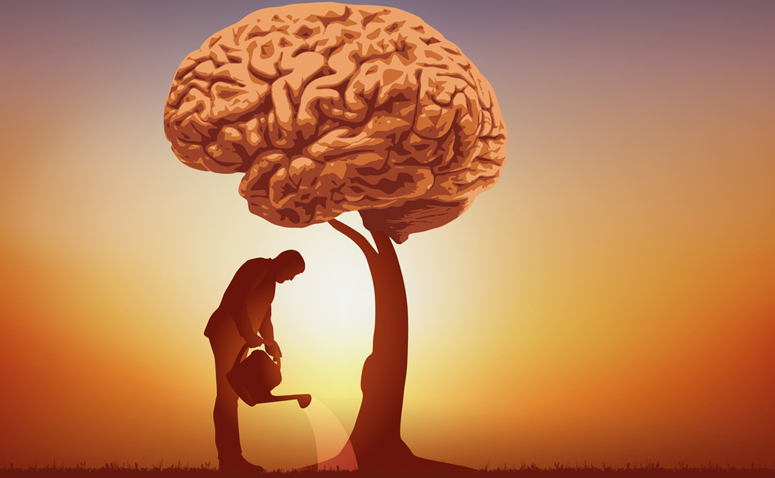- May 17, 2020
- Posted by: admin
- Category: Blogs

Integrating Mindfulness in Education
Adapting in times of COVID-19
In the shift to distance learning, we need a response that addresses the overall health and sustainability of learning environments and one that supports the well-being of every educator, student, and member of the school community. This means that educators will need to actively focus on maintaining attitudes of inclusivity, as they diligently prepare for a fundamentally different learning program required by this new reality.

This article is inspired by my experience as a doctoral student, studying alongside talented students and experienced faculty members. In the last few years, the effects of mindfulness on students have been of the highest interest for educators and various researchers. There are multiple studies that suggest the different benefits that mindfulness has on students, and how this helps them to overcome the levels of stress that they face in their day-to-day classroom routines.
Today’s educators and students carry so much on their shoulders. Meeting academic and social expectations – simply growing up and developing a sense of self and belonging – can be tough. Yet the pressures in today’s educational environment reach far beyond these basics. Our world is moving and changing faster than ever.
Since mindfulness is no longer a new phenomenon, this article hopes to shed light on some issues around the practice of mindfulness in education and to provide mindfulness approaches that have been adopted and incorporated in curriculums. Here, we open the platform for educators and students to understand the benefits of mindfulness that can influence their (students) behavior and academics. These benefits are derived by the teachers from mindfulness, with findings that suggest the positive impact mindfulness has on the students as well as teachers.
The Integration of mindfulness in education reviews how practicing mindfulness in the classroom affects students by highlighting some key findings and issues in current literature.
In an age of digital distractions, mindfulness has become a billion-dollar industry that extends well beyond training to include services and experiences. Thus, it is incumbent upon educators to understand the phenomenon of mindfulness and its difficulties.
The increasing number of Mindfulness Studies across disciplines
Stimuli, distractions, and interruptions are ubiquitous in the classrooms today. On top of that, there is a growing pressure to navigate our recent reality. One solution that a growing number of colleges, institutes, and universities are embracing is “mindfulness” — a technique to tune out the noise and focus deliberately on what is important.

In recent years, there have been a growing number of studies on mindfulness practice in education. Jon Kabat-Zinn (2011) brings to light the increasing number of mindfulness studies across disciplines and some instances of its implementation in healthcare and educational settings. The widespread use of this practice of using mindfulness has helped students learn how to slow their thoughts, listen, communicate, focus, and become better students. It is time to draw our attention to mindfulness for cultivating focus, resilience, and well-being for academic success.
Why Mindfulness in Education?
Based on my research and consulting experiences related to designing and delivering programs for varied corporations, I will explain how mindfulness in education can broaden students’ and educators’ productivity skills, and improve decision-making and enhance well-being.
Various researchers have suggested that practicing mindfulness can help in improving academic performance regarding developing concentration, upgrading memory, and increasing attention that can further assist in managing the level of stress (Schonert-Reichl, 2010).

It has been observed that academic life is not that easy; instead, it is very tough, where students face many challenges in day-to-day activities. Consequently, for balancing the struggle in academic life, it is important to practice mindfulness. Mindfulness is mainly concerned with bringing awareness to the present moment, and experiencing what we are doing presently to the fullest extent possible. If we look at the mindfulness activities from a level that is a bit broader, they would suggest that mindfulness helps in developing the whole person. This allows us to consider the more general purpose of education, and its transformational role in the development of the human being.
According to various researchers, it has been observed that meditation helps in enhancing memory and compassion (care), which helps in concentration and remembering information. This leads to improved attention and memory. According to some studies, it is suggested that meditation serves as an antidepressant that combats anxiety and depression (Bergen-Cico, 2013).
Mindfulness as a practice is becoming recognized by schools as a beneficial practice for students, residents, and faculty, and it is cultivated to promote educator self-care, self-awareness, and empathy, with the ultimate aim of mutually improving educator well-being and the quality of student care. Mindfulness is believed to increase test scores and academic achievement, due to the fact that it allows students to calm themselves down and focus on the task at hand.
|
Social Benefits Enhancing relationships: Through mindfulness training, a person can feel more relaxed and optimistic and can be more satisfied with their relationships. Fostering altruism and compassion: People who are into meditation are more likely to practice self-care, and they demonstrate compassion, empathy, and care for others (Wisdom Commons, 2015). |
Physical Benefits Positive changes in the brain: It is said that when we sit quietly and calmly in the present moment, it changes our minds. Boosting the immune system: According to various researchers; it has been said that just eight weeks of mindfulness training helps the immune system to fight illness (Wisner, 2010). | Psychological Benefits Reducing stress and negative emotions: It has been observed that through proper meditation and mindfulness there is a reduction in stress and it helps in reducing the negative feelings as well. |
Benefits of mindfulness described in domains (physical, social, and psychological) by Wisner, (2010), Bergen-Cico, (2013), and Wisdom Commons, (2015).
Introducing Mindfulness to the Classrooms
There have been many forms and shapes taken by school-based mindfulness programs to include subjects like physical education. In Western Canada, many schools have brought Mindfulness programs in the form of stand-alone programs by implementing a ten-week Mindfulness education curriculum.

In such programs, different weekly training sessions were based on Mindfulness practices, including focused attention, and stress reduction through attentive listening, along with various breathing exercises. The MBSR program is primarily an eight-week program that helps teach the importance of Mindfulness in everyday life through body-scan exercises, mindfulness breathing, and Yoga.
Implementing Mindfulness in an Age of Distraction
This section briefly focuses on how to implement Mindfulness strategies in the classroom even with the varied digital distractions:
-
Planning: A strong program introduction/implementation plan is essential. For instance, the MindUp program provides students with “learning about your brain,” which helps the students to understand the connection between their brain, thinking, and feeling guided by their behavior.
-
Patience: Learning to be mindful takes practice, and this lack of immediate results while practicing causes further drawbacks. It is possible that the mindfulness activities may not have positive results immediately; however, it is also worth noting that if practiced on a continuous basis (case-by-case, this may not be the case in every situation), the results can be positive in a short time span.
-
Positioning: The aspect of positioning lies with teachers’ timing, who might not be able to take enough time from their busy schedule to implement Mindfulness strategies in the classroom. For instance, the current teachers’ shortage issue in BC can present a time barrier for those teachers wanting to train or implement Mindfulness in their classrooms.
The Role Mindfulness in Mental Health
As a preventive tool for the different mental health issues and behavioral challenges, mindfulness plays a pivotal role in the lives of students. Mindfulness helps to foster a positive classroom environment that allows its introduction to serve a very important need (Berkovitch-Ohana, 2014). There is a growing need that addresses the benefits of mindfulness training or meditation for adults that includes improvement in psychological functioning and development in immune functioning and brain functioning.
It has been found by various researchers that meditation has a high potential to provide health benefits, especially in the case of stress reduction. In school-based settings, Mindfulness and Meditation help in improving the academic performance of adolescents that have learning disabilities (Meiklejohn et al., 2012).
Scholars like Meiklejohn et al. (2012), Shardlow (2015), and many more have emphasized ways of directing one’s attention to a specific area of focus (such as the breath, a sensation, a feeling (e.g., loving-kindness), or other attentional media, to apply mindfulness in the curriculum:
Mindfulness through breath.

When a student is anxious, often they intake shallow breaths in their chests. Mindfulness through Breath uses the breath as an object of concentration by focusing on the breath to become aware and be in the present moment. As students have a tendency to lose concentration easily, breathing exercises like breathing deeply into the belly can help calm the body as well as focus the brain.
Mindfulness through movement.

Movement is significant for keeping the body in shape. One of the single strategies of adding movement to the body is Yoga. Students can practice yoga in their chairs, at the gym, or outside.
Mindfulness through guided imagery.
Here children often develop their imaginations. It also helps in learning with prior knowledge. While starting a new topic, students shall be asked to close their eyes and pretend to be on a journey where they shall imagine something about the topic, and end the guided relaxation through a few deep breaths, and then discuss the images that students in the classroom experience.
Mindfulness through sensory experience

Sensory experiences can support focus and relaxation and through the practice of listening to music or some calming sounds in the classrooms, or sounds of nature outside. This can help students listen and focus better while learning (Shardlow, 2015). Mindfulness can also help in targeting the self-regulatory abilities that are primarily used to respond to stress levels in a very efficient and calm manner.
Navigating stress through Mindful Practice
According to Greenberg, mindfulness can provide a foundation for improved social and emotional adjustment and academic performance as demonstrated by more positive social behaviors, fewer conduct problems, less emotional distress, and improved test scores and grades.
The stress that is experienced by students often results in depression, anxiety, and other emotional, behavioral problems, which also disrupt thinking and negatively influence scholastic performance. One is required to navigate stress through self-regulation calmly. When there is a high-stress situation, it often leads to the activation of the reptilian brain, which is a part of the brain that controls breathing, heart-rate, and body temperature. After this, it shuts down the various other functions of the brain that includes an area of the prefrontal cortex, which is mainly used for self-regulation and learning, so that the energy that is needed for fleeing or fighting can be maximized.

Teachers are implementing mindfulness in classrooms by using a gentle approach where the participation of students is considered optional and pressure is set to low (or none, as in cases like K-12). The goal at this stage is to start with baby steps so that the momentum can be built gradually without force. Being explicit while communicating the goals of Mindfulness training is an essential component for younger children. In the MindUP program, the drivers of the program started with an introduction to the brain, to ensure that younger students gain orientation and an understanding of the scientific aspects of the brain.
The stress that is experienced by the students often results in depression, anxiety, and other emotional, behavioral problems, which also disrupt thinking and negatively influence scholastic performance. One is required to navigate stress through self-regulation calmly. When there is a high-stress situation, it often leads to the activation of the reptilian brain, which is a part of the brain that controls breathing, heart rate, and body temperature. After this, it shuts down the various other functions of the brain that includes an area of the prefrontal cortex, which is mainly used for self-regulation and learning, so that the energy that is needed for fleeing or fighting can be maximized.
Drawbacks on Mindfulness Practice in Education
The practice of Mindfulness, as with any other practice, comes with some drawbacks, and these are different from one context to another.
-
Religious connotations are considered one of the most significant barriers to implementing Mindfulness into student programs. Mindfulness comes from Buddhist philosophy, so there might be a few people who are reluctant to implement it, for that reason. As a Christian, I have had friends with similar religious backgrounds question my interest in the practice of Mindfulness.
-
Poor judgment on the part of the students (older students) at the initial stage of implementation can cause major drawbacks.
-
Uncertainties surrounding the practice of Mindfulness in education. Although many educators are introducing Mindfulness into the classroom as a means of improving student attention and emotional regulation, the limited research brings people to realize that many questions are still unanswered.
Top 5 Mindful Tips for Educators during COVID-19
As the number of COVID-19 cases continues to rise across the globe, stress and anxiety around the virus have risen right alongside them.
-
Continually gauge stress and engagement levels: Take time to check in with your students, whether virtually or in person. Take note of the student’s state of mind, energy level, look for the unsaid.
-
Listen: Practice mindful listening. It is recommended that students be given a space platform to discuss and talk through their fears and apprehensions. Give your students the space to be open and honest about how they feel, both mentally and physically.
-
Model optimism and drain the class of fear: With everyone feeling a range of different emotions, take steps to demonstrate hopefulness and confidence in the future. Do not get trapped with letting frustrations get in the way: Pause and give yourself space as you continue to demonstrate Optimism.
-
Give students Support: Assign student buddies and peer coaches to add a layer of mutual support in the classroom. Support continued learning and continually gauge stress and engagement level.
-
Reset your expectations: Letting go of when and how assignments/ projects are completed, allowing students to accomplish their learning on their own terms (with guided support). Share all expectations of student engagement and the processes, and requirements, ensuring that there is a clear understanding that circumstances can change regularly.
Most importantly, ask each of your students how you can help them because, acknowledging how they truly feel not only creates the chance for dialogue, it also empowers you to respond with kindness. It also helps to stay abreast of support available for students – especially if you have international students in your classroom.
Training Materials and Support for Educators
Mindfulness training for institutions of higher education is increasing with various opportunities to expand awareness that go beyond short courses and workshops, to explore and integrate mindfulness strategies into the classrooms, communities of practice, and curriculum. There are several Mindfulness training groups, like MindUp, Mindfulness Training Institutes across the world, and several other centers for Mindfulness training, designed for teachers who choose to implement Mindfulness practices in their classrooms.
Recommendation / Conclusion
There have been quite a few recommended strategies adopted along the way that have helped support the implementation of Mindfulness. DiGiovanni (2017) mentioned the benefit of creating collaborative teams (fellow classroom teachers, educational assistants, and child care workers) to support teachers practicing Mindfulness. This was a paper that focused on interviews from six administrators and six teachers at five elementary schools, so it can hardly pass as applicable in all contexts.
I thought it was worth mentioning under this section that it is time for public health officials and policymakers to get behind a commitment to scaling up access to Mindfulness practices in education. Simple measures like controlled certification can provide some uniformity in the practice and can provide a means of holding teachers responsible/accountable for reporting back on their experiences.
To answer the questions around mindful practices, something needed is a profound change; a shift of mindset; one that will be welcomed and embraced by all Mindfulness practitioners, scholars, researchers, school authorities, and teaching practices.
Based on the literature review in this paper, most believe that there is a gap in Mindfulness integration in education, yet very few are taking the necessary steps to develop solutions and ensure that the practice flourishes. To drive this shift of mindset, a critical move to transform the mandate and scope of the controlling body (committee) is needed. Just as many audit committees have evolved into bodies focused on strategic systems, Mindfulness practice in education must evolve to form a committee that is focused on the training, deployment, and development of Mindfulness practices.
It can be concluded that Mindfulness interventions can be utilized in general classrooms, and might have promising results in the behavioral, social, and attention domains. Mindfulness practices could transform people, and it becomes the necessity of every school or institution, to ensure that the hype for Mindfulness is backed up with research, a Mindfulness community, or a governing body must be established to ensure its continued efficacy.
 Author Author Gifty Parker is the Founder and Executive Director at PARKER HR. She oversees all Leadership Training Programs, Talent Excellence Programs, and shares the responsibility of HR Manager for dnata Catering Canada Limited. |
 Page Layout Pedro Rocha is the Business Administrative Intern at PARKER HR. He has a degree in accounting in Brazil and is finishing his business administration course in Canada. He comes with experience in people management acquired while working in private and non-profit organization, AIESEC. |

